A Study on SCM Practices in Five and Seven Star Hotels in India
VerifiedAdded on 2020/03/16
|23
|4701
|148
Report
AI Summary
This report provides an in-depth analysis of Supply Chain Management (SCM) practices within the five and seven-star hotel industry in India. The study investigates the current SCM approaches, benefits, and challenges faced by these establishments, with the aim of understanding how effective SCM impacts customer satisfaction, loyalty, and overall operational efficiency. The research includes a review of existing literature, problem statement, research objectives, prior work, and hypotheses, as well as a discussion of the methodology used, including the use of questionnaires. The report examines the significance of SCM in the context of India's growing hospitality sector, considering its role in improving profitability, customer service, and competitive advantage. Furthermore, the report highlights key stakeholders, elements, and the impact of technology and globalization on the hotel industry's SCM strategies. The study concludes with an assessment of the relationships between SCM implementation, service quality, and customer repeat rates, offering valuable insights for hotel management and SCM professionals.
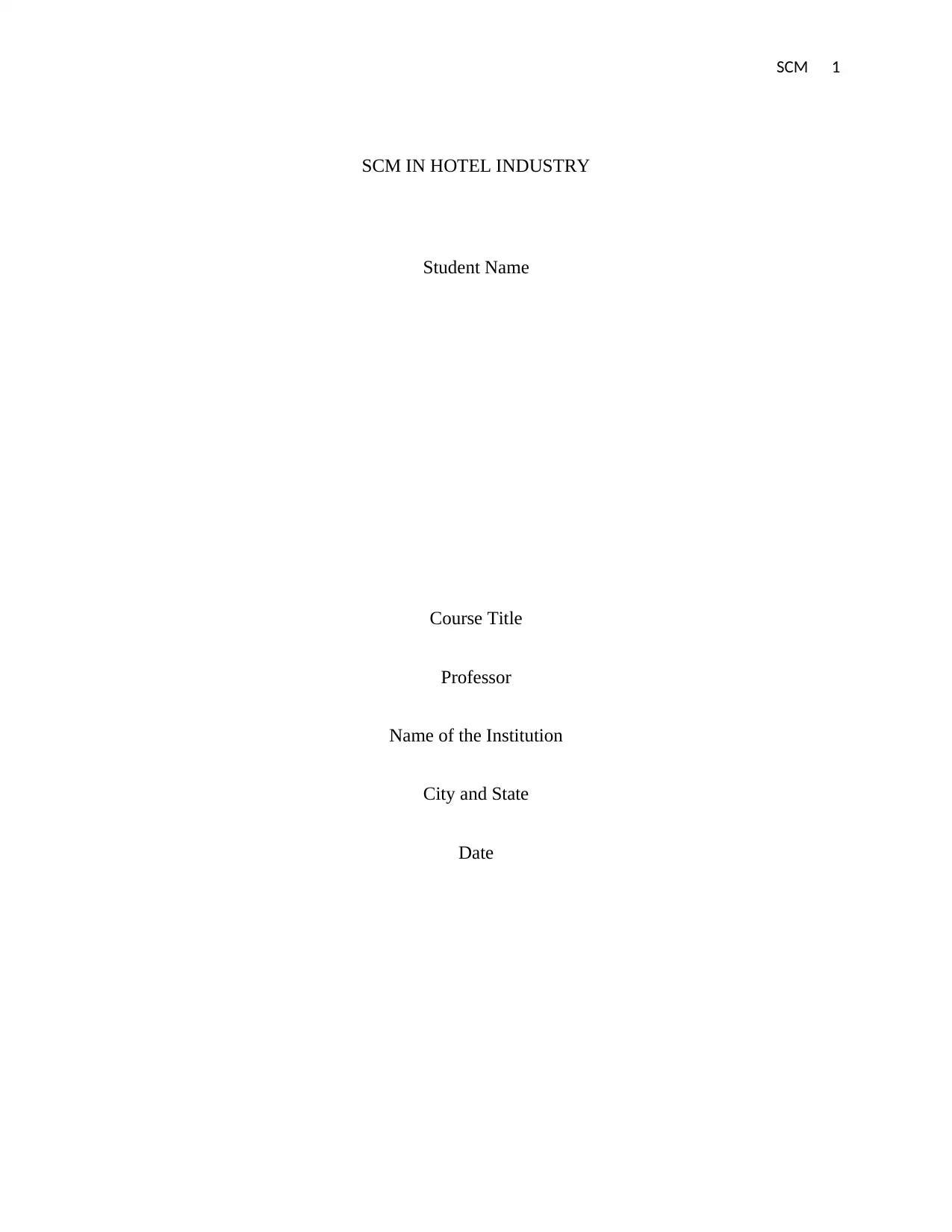
SCM 1
SCM IN HOTEL INDUSTRY
Student Name
Course Title
Professor
Name of the Institution
City and State
Date
SCM IN HOTEL INDUSTRY
Student Name
Course Title
Professor
Name of the Institution
City and State
Date
Paraphrase This Document
Need a fresh take? Get an instant paraphrase of this document with our AI Paraphraser
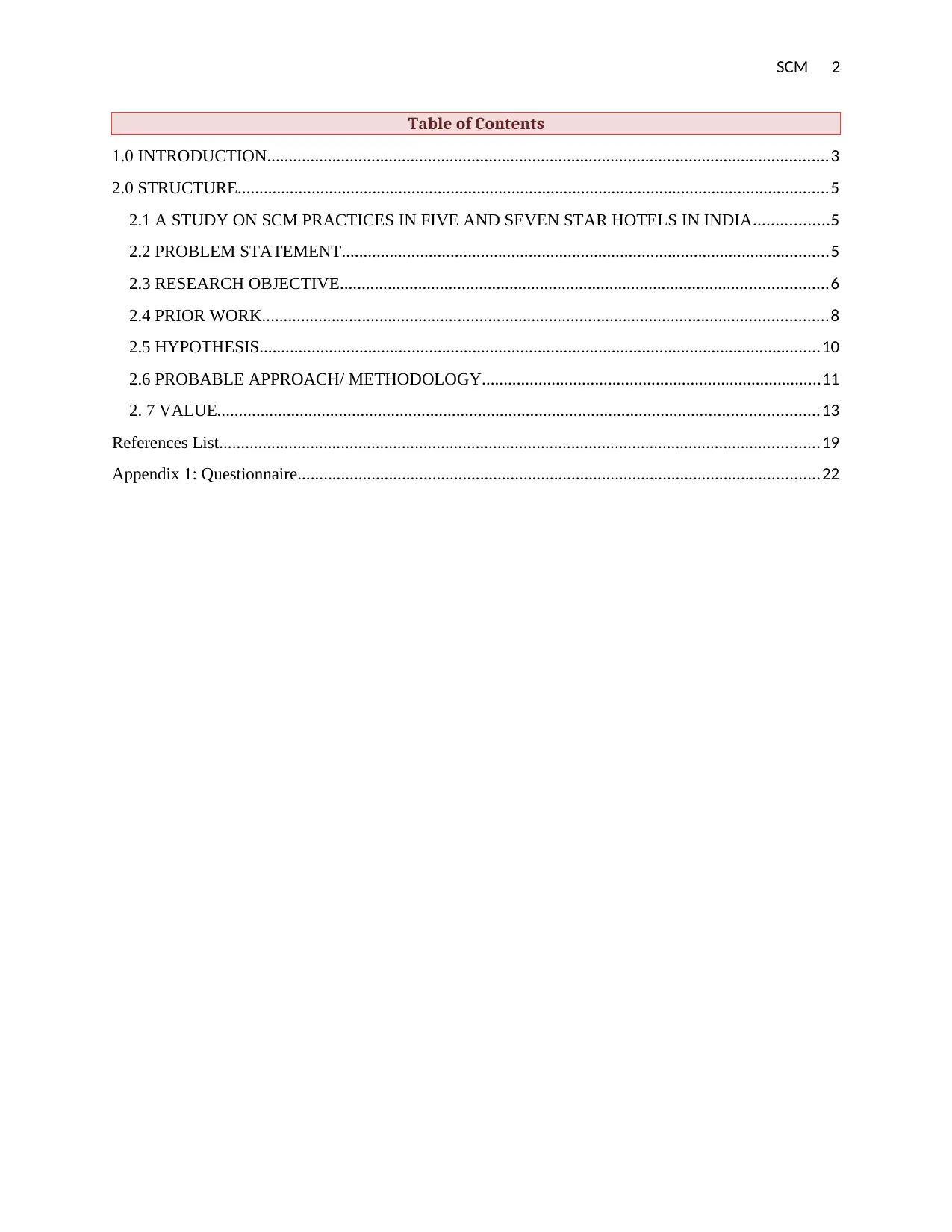
SCM 2
Table of Contents
1.0 INTRODUCTION.................................................................................................................................3
2.0 STRUCTURE........................................................................................................................................5
2.1 A STUDY ON SCM PRACTICES IN FIVE AND SEVEN STAR HOTELS IN INDIA.................5
2.2 PROBLEM STATEMENT................................................................................................................5
2.3 RESEARCH OBJECTIVE................................................................................................................6
2.4 PRIOR WORK..................................................................................................................................8
2.5 HYPOTHESIS.................................................................................................................................10
2.6 PROBABLE APPROACH/ METHODOLOGY..............................................................................11
2. 7 VALUE..........................................................................................................................................13
References List..........................................................................................................................................19
Appendix 1: Questionnaire........................................................................................................................22
Table of Contents
1.0 INTRODUCTION.................................................................................................................................3
2.0 STRUCTURE........................................................................................................................................5
2.1 A STUDY ON SCM PRACTICES IN FIVE AND SEVEN STAR HOTELS IN INDIA.................5
2.2 PROBLEM STATEMENT................................................................................................................5
2.3 RESEARCH OBJECTIVE................................................................................................................6
2.4 PRIOR WORK..................................................................................................................................8
2.5 HYPOTHESIS.................................................................................................................................10
2.6 PROBABLE APPROACH/ METHODOLOGY..............................................................................11
2. 7 VALUE..........................................................................................................................................13
References List..........................................................................................................................................19
Appendix 1: Questionnaire........................................................................................................................22
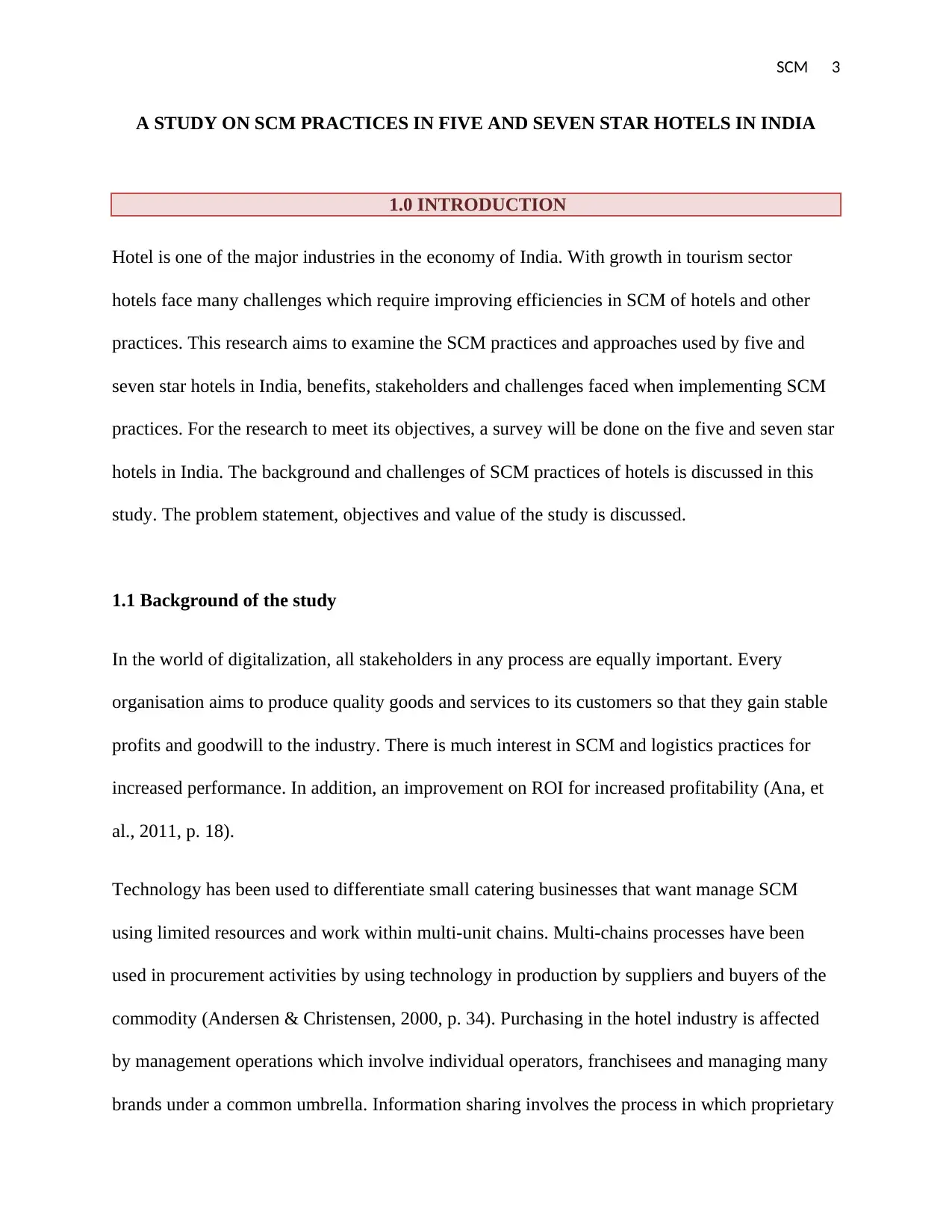
SCM 3
A STUDY ON SCM PRACTICES IN FIVE AND SEVEN STAR HOTELS IN INDIA
1.0 INTRODUCTION
Hotel is one of the major industries in the economy of India. With growth in tourism sector
hotels face many challenges which require improving efficiencies in SCM of hotels and other
practices. This research aims to examine the SCM practices and approaches used by five and
seven star hotels in India, benefits, stakeholders and challenges faced when implementing SCM
practices. For the research to meet its objectives, a survey will be done on the five and seven star
hotels in India. The background and challenges of SCM practices of hotels is discussed in this
study. The problem statement, objectives and value of the study is discussed.
1.1 Background of the study
In the world of digitalization, all stakeholders in any process are equally important. Every
organisation aims to produce quality goods and services to its customers so that they gain stable
profits and goodwill to the industry. There is much interest in SCM and logistics practices for
increased performance. In addition, an improvement on ROI for increased profitability (Ana, et
al., 2011, p. 18).
Technology has been used to differentiate small catering businesses that want manage SCM
using limited resources and work within multi-unit chains. Multi-chains processes have been
used in procurement activities by using technology in production by suppliers and buyers of the
commodity (Andersen & Christensen, 2000, p. 34). Purchasing in the hotel industry is affected
by management operations which involve individual operators, franchisees and managing many
brands under a common umbrella. Information sharing involves the process in which proprietary
A STUDY ON SCM PRACTICES IN FIVE AND SEVEN STAR HOTELS IN INDIA
1.0 INTRODUCTION
Hotel is one of the major industries in the economy of India. With growth in tourism sector
hotels face many challenges which require improving efficiencies in SCM of hotels and other
practices. This research aims to examine the SCM practices and approaches used by five and
seven star hotels in India, benefits, stakeholders and challenges faced when implementing SCM
practices. For the research to meet its objectives, a survey will be done on the five and seven star
hotels in India. The background and challenges of SCM practices of hotels is discussed in this
study. The problem statement, objectives and value of the study is discussed.
1.1 Background of the study
In the world of digitalization, all stakeholders in any process are equally important. Every
organisation aims to produce quality goods and services to its customers so that they gain stable
profits and goodwill to the industry. There is much interest in SCM and logistics practices for
increased performance. In addition, an improvement on ROI for increased profitability (Ana, et
al., 2011, p. 18).
Technology has been used to differentiate small catering businesses that want manage SCM
using limited resources and work within multi-unit chains. Multi-chains processes have been
used in procurement activities by using technology in production by suppliers and buyers of the
commodity (Andersen & Christensen, 2000, p. 34). Purchasing in the hotel industry is affected
by management operations which involve individual operators, franchisees and managing many
brands under a common umbrella. Information sharing involves the process in which proprietary
⊘ This is a preview!⊘
Do you want full access?
Subscribe today to unlock all pages.

Trusted by 1+ million students worldwide
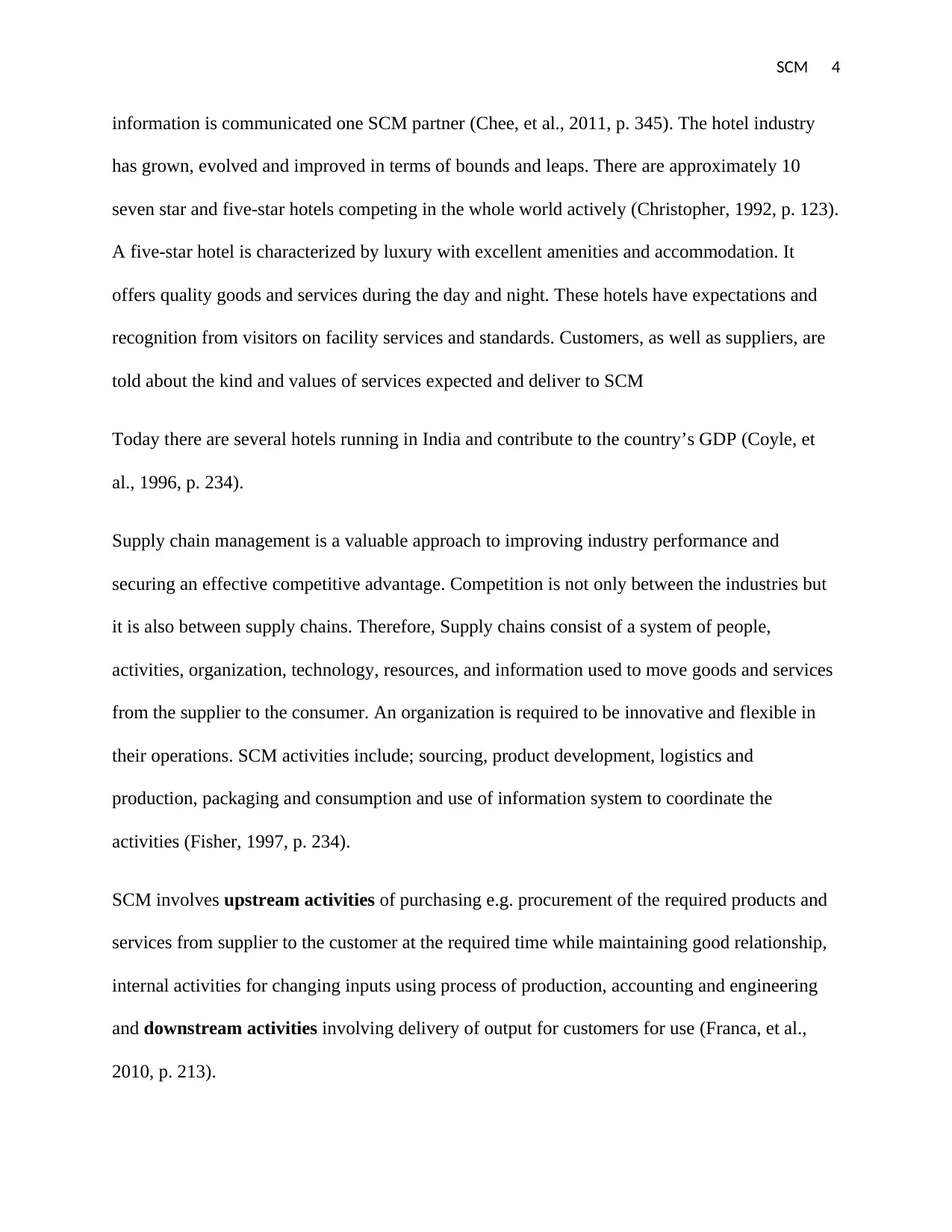
SCM 4
information is communicated one SCM partner (Chee, et al., 2011, p. 345). The hotel industry
has grown, evolved and improved in terms of bounds and leaps. There are approximately 10
seven star and five-star hotels competing in the whole world actively (Christopher, 1992, p. 123).
A five-star hotel is characterized by luxury with excellent amenities and accommodation. It
offers quality goods and services during the day and night. These hotels have expectations and
recognition from visitors on facility services and standards. Customers, as well as suppliers, are
told about the kind and values of services expected and deliver to SCM
Today there are several hotels running in India and contribute to the country’s GDP (Coyle, et
al., 1996, p. 234).
Supply chain management is a valuable approach to improving industry performance and
securing an effective competitive advantage. Competition is not only between the industries but
it is also between supply chains. Therefore, Supply chains consist of a system of people,
activities, organization, technology, resources, and information used to move goods and services
from the supplier to the consumer. An organization is required to be innovative and flexible in
their operations. SCM activities include; sourcing, product development, logistics and
production, packaging and consumption and use of information system to coordinate the
activities (Fisher, 1997, p. 234).
SCM involves upstream activities of purchasing e.g. procurement of the required products and
services from supplier to the customer at the required time while maintaining good relationship,
internal activities for changing inputs using process of production, accounting and engineering
and downstream activities involving delivery of output for customers for use (Franca, et al.,
2010, p. 213).
information is communicated one SCM partner (Chee, et al., 2011, p. 345). The hotel industry
has grown, evolved and improved in terms of bounds and leaps. There are approximately 10
seven star and five-star hotels competing in the whole world actively (Christopher, 1992, p. 123).
A five-star hotel is characterized by luxury with excellent amenities and accommodation. It
offers quality goods and services during the day and night. These hotels have expectations and
recognition from visitors on facility services and standards. Customers, as well as suppliers, are
told about the kind and values of services expected and deliver to SCM
Today there are several hotels running in India and contribute to the country’s GDP (Coyle, et
al., 1996, p. 234).
Supply chain management is a valuable approach to improving industry performance and
securing an effective competitive advantage. Competition is not only between the industries but
it is also between supply chains. Therefore, Supply chains consist of a system of people,
activities, organization, technology, resources, and information used to move goods and services
from the supplier to the consumer. An organization is required to be innovative and flexible in
their operations. SCM activities include; sourcing, product development, logistics and
production, packaging and consumption and use of information system to coordinate the
activities (Fisher, 1997, p. 234).
SCM involves upstream activities of purchasing e.g. procurement of the required products and
services from supplier to the customer at the required time while maintaining good relationship,
internal activities for changing inputs using process of production, accounting and engineering
and downstream activities involving delivery of output for customers for use (Franca, et al.,
2010, p. 213).
Paraphrase This Document
Need a fresh take? Get an instant paraphrase of this document with our AI Paraphraser
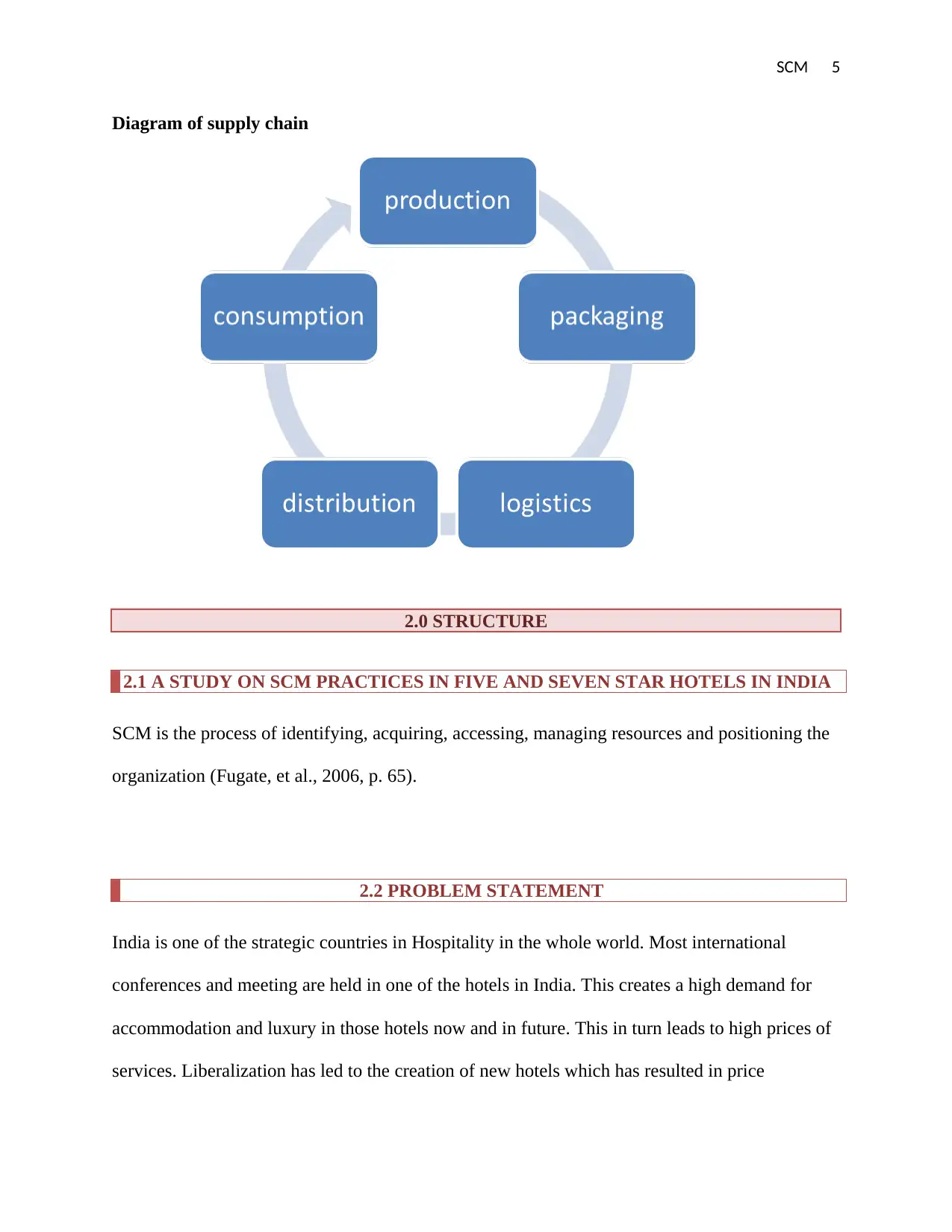
SCM 5
Diagram of supply chain
2.0 STRUCTURE
2.1 A STUDY ON SCM PRACTICES IN FIVE AND SEVEN STAR HOTELS IN INDIA
SCM is the process of identifying, acquiring, accessing, managing resources and positioning the
organization (Fugate, et al., 2006, p. 65).
2.2 PROBLEM STATEMENT
India is one of the strategic countries in Hospitality in the whole world. Most international
conferences and meeting are held in one of the hotels in India. This creates a high demand for
accommodation and luxury in those hotels now and in future. This in turn leads to high prices of
services. Liberalization has led to the creation of new hotels which has resulted in price
Diagram of supply chain
2.0 STRUCTURE
2.1 A STUDY ON SCM PRACTICES IN FIVE AND SEVEN STAR HOTELS IN INDIA
SCM is the process of identifying, acquiring, accessing, managing resources and positioning the
organization (Fugate, et al., 2006, p. 65).
2.2 PROBLEM STATEMENT
India is one of the strategic countries in Hospitality in the whole world. Most international
conferences and meeting are held in one of the hotels in India. This creates a high demand for
accommodation and luxury in those hotels now and in future. This in turn leads to high prices of
services. Liberalization has led to the creation of new hotels which has resulted in price
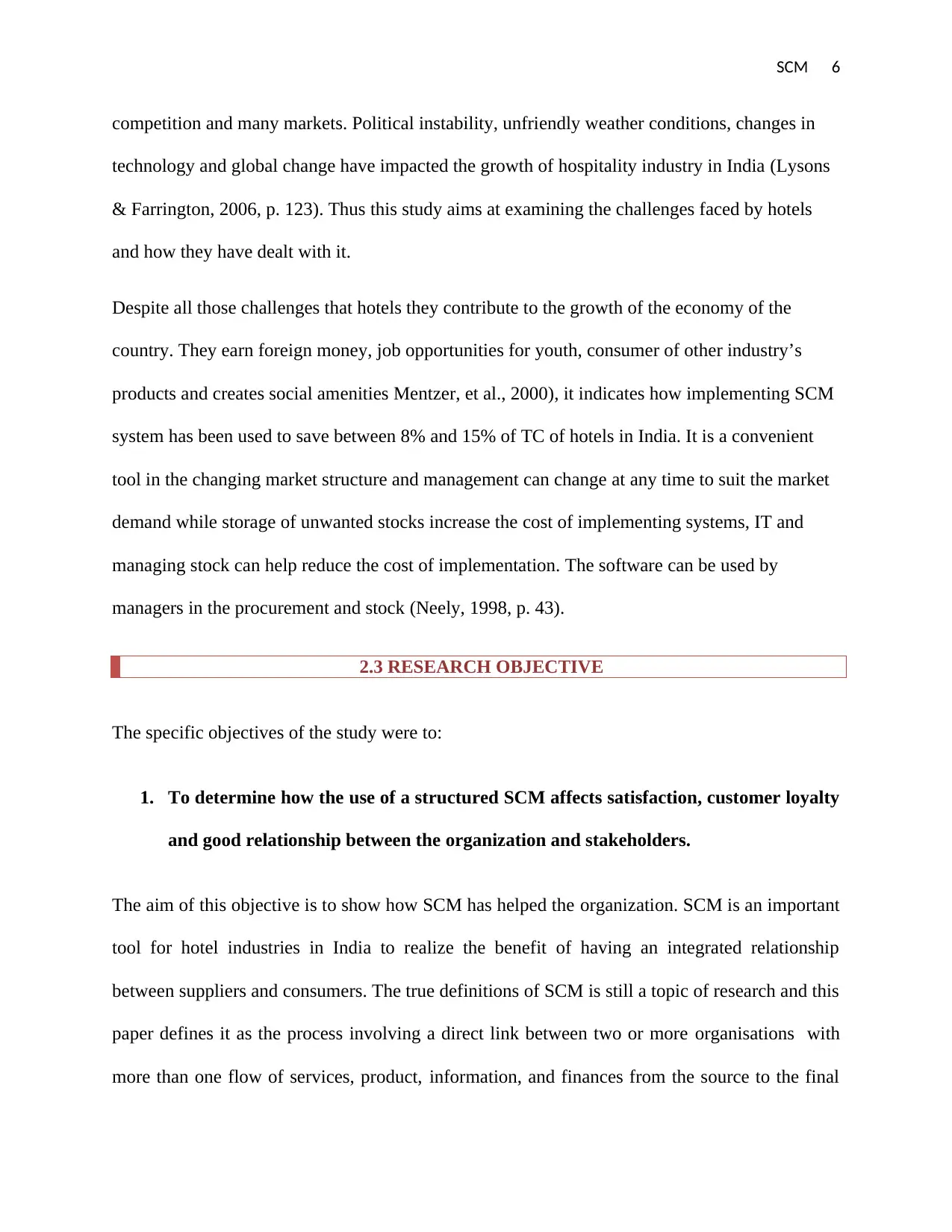
SCM 6
competition and many markets. Political instability, unfriendly weather conditions, changes in
technology and global change have impacted the growth of hospitality industry in India (Lysons
& Farrington, 2006, p. 123). Thus this study aims at examining the challenges faced by hotels
and how they have dealt with it.
Despite all those challenges that hotels they contribute to the growth of the economy of the
country. They earn foreign money, job opportunities for youth, consumer of other industry’s
products and creates social amenities Mentzer, et al., 2000), it indicates how implementing SCM
system has been used to save between 8% and 15% of TC of hotels in India. It is a convenient
tool in the changing market structure and management can change at any time to suit the market
demand while storage of unwanted stocks increase the cost of implementing systems, IT and
managing stock can help reduce the cost of implementation. The software can be used by
managers in the procurement and stock (Neely, 1998, p. 43).
2.3 RESEARCH OBJECTIVE
The specific objectives of the study were to:
1. To determine how the use of a structured SCM affects satisfaction, customer loyalty
and good relationship between the organization and stakeholders.
The aim of this objective is to show how SCM has helped the organization. SCM is an important
tool for hotel industries in India to realize the benefit of having an integrated relationship
between suppliers and consumers. The true definitions of SCM is still a topic of research and this
paper defines it as the process involving a direct link between two or more organisations with
more than one flow of services, product, information, and finances from the source to the final
competition and many markets. Political instability, unfriendly weather conditions, changes in
technology and global change have impacted the growth of hospitality industry in India (Lysons
& Farrington, 2006, p. 123). Thus this study aims at examining the challenges faced by hotels
and how they have dealt with it.
Despite all those challenges that hotels they contribute to the growth of the economy of the
country. They earn foreign money, job opportunities for youth, consumer of other industry’s
products and creates social amenities Mentzer, et al., 2000), it indicates how implementing SCM
system has been used to save between 8% and 15% of TC of hotels in India. It is a convenient
tool in the changing market structure and management can change at any time to suit the market
demand while storage of unwanted stocks increase the cost of implementing systems, IT and
managing stock can help reduce the cost of implementation. The software can be used by
managers in the procurement and stock (Neely, 1998, p. 43).
2.3 RESEARCH OBJECTIVE
The specific objectives of the study were to:
1. To determine how the use of a structured SCM affects satisfaction, customer loyalty
and good relationship between the organization and stakeholders.
The aim of this objective is to show how SCM has helped the organization. SCM is an important
tool for hotel industries in India to realize the benefit of having an integrated relationship
between suppliers and consumers. The true definitions of SCM is still a topic of research and this
paper defines it as the process involving a direct link between two or more organisations with
more than one flow of services, product, information, and finances from the source to the final
⊘ This is a preview!⊘
Do you want full access?
Subscribe today to unlock all pages.

Trusted by 1+ million students worldwide
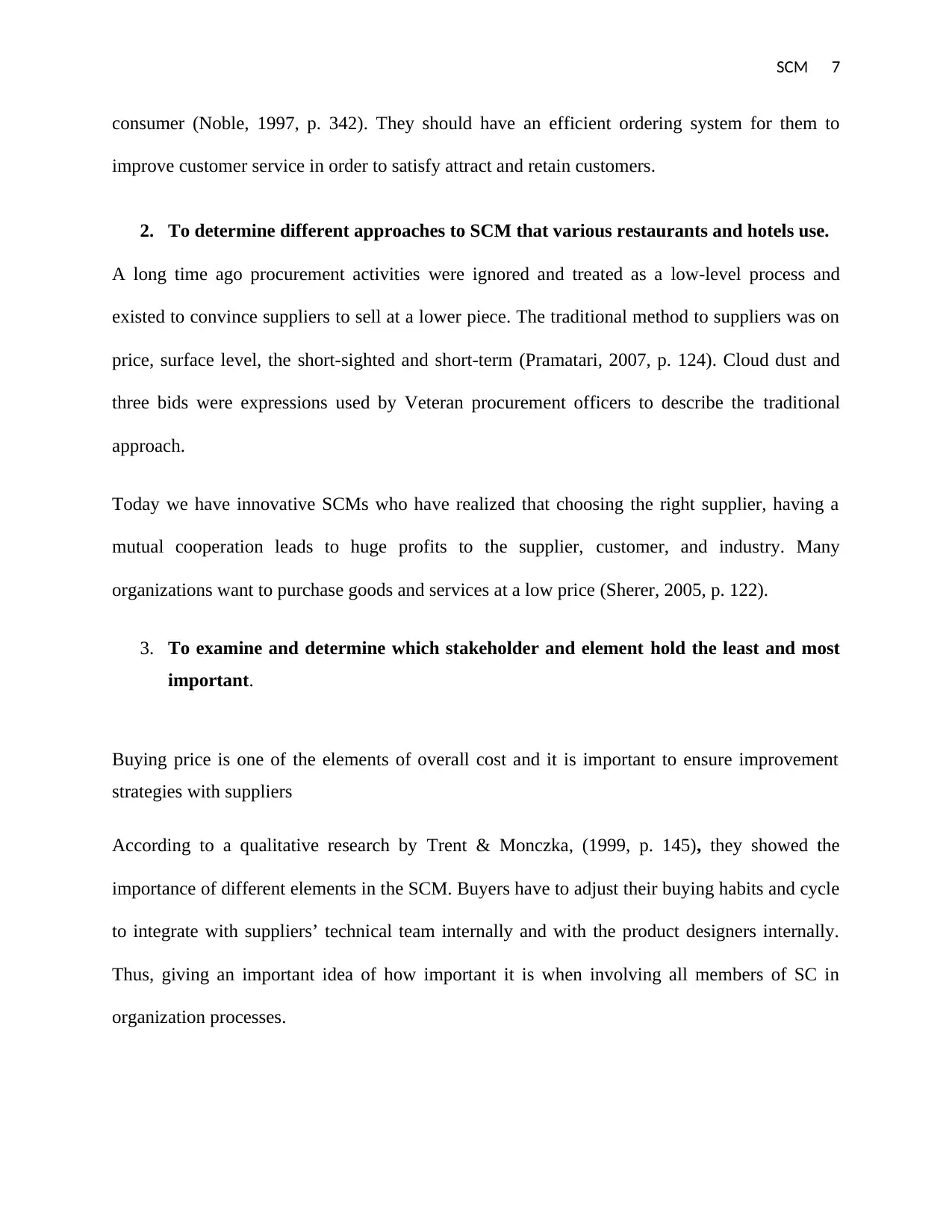
SCM 7
consumer (Noble, 1997, p. 342). They should have an efficient ordering system for them to
improve customer service in order to satisfy attract and retain customers.
2. To determine different approaches to SCM that various restaurants and hotels use.
A long time ago procurement activities were ignored and treated as a low-level process and
existed to convince suppliers to sell at a lower piece. The traditional method to suppliers was on
price, surface level, the short-sighted and short-term (Pramatari, 2007, p. 124). Cloud dust and
three bids were expressions used by Veteran procurement officers to describe the traditional
approach.
Today we have innovative SCMs who have realized that choosing the right supplier, having a
mutual cooperation leads to huge profits to the supplier, customer, and industry. Many
organizations want to purchase goods and services at a low price (Sherer, 2005, p. 122).
3. To examine and determine which stakeholder and element hold the least and most
important.
Buying price is one of the elements of overall cost and it is important to ensure improvement
strategies with suppliers
According to a qualitative research by Trent & Monczka, (1999, p. 145), they showed the
importance of different elements in the SCM. Buyers have to adjust their buying habits and cycle
to integrate with suppliers’ technical team internally and with the product designers internally.
Thus, giving an important idea of how important it is when involving all members of SC in
organization processes.
consumer (Noble, 1997, p. 342). They should have an efficient ordering system for them to
improve customer service in order to satisfy attract and retain customers.
2. To determine different approaches to SCM that various restaurants and hotels use.
A long time ago procurement activities were ignored and treated as a low-level process and
existed to convince suppliers to sell at a lower piece. The traditional method to suppliers was on
price, surface level, the short-sighted and short-term (Pramatari, 2007, p. 124). Cloud dust and
three bids were expressions used by Veteran procurement officers to describe the traditional
approach.
Today we have innovative SCMs who have realized that choosing the right supplier, having a
mutual cooperation leads to huge profits to the supplier, customer, and industry. Many
organizations want to purchase goods and services at a low price (Sherer, 2005, p. 122).
3. To examine and determine which stakeholder and element hold the least and most
important.
Buying price is one of the elements of overall cost and it is important to ensure improvement
strategies with suppliers
According to a qualitative research by Trent & Monczka, (1999, p. 145), they showed the
importance of different elements in the SCM. Buyers have to adjust their buying habits and cycle
to integrate with suppliers’ technical team internally and with the product designers internally.
Thus, giving an important idea of how important it is when involving all members of SC in
organization processes.
Paraphrase This Document
Need a fresh take? Get an instant paraphrase of this document with our AI Paraphraser
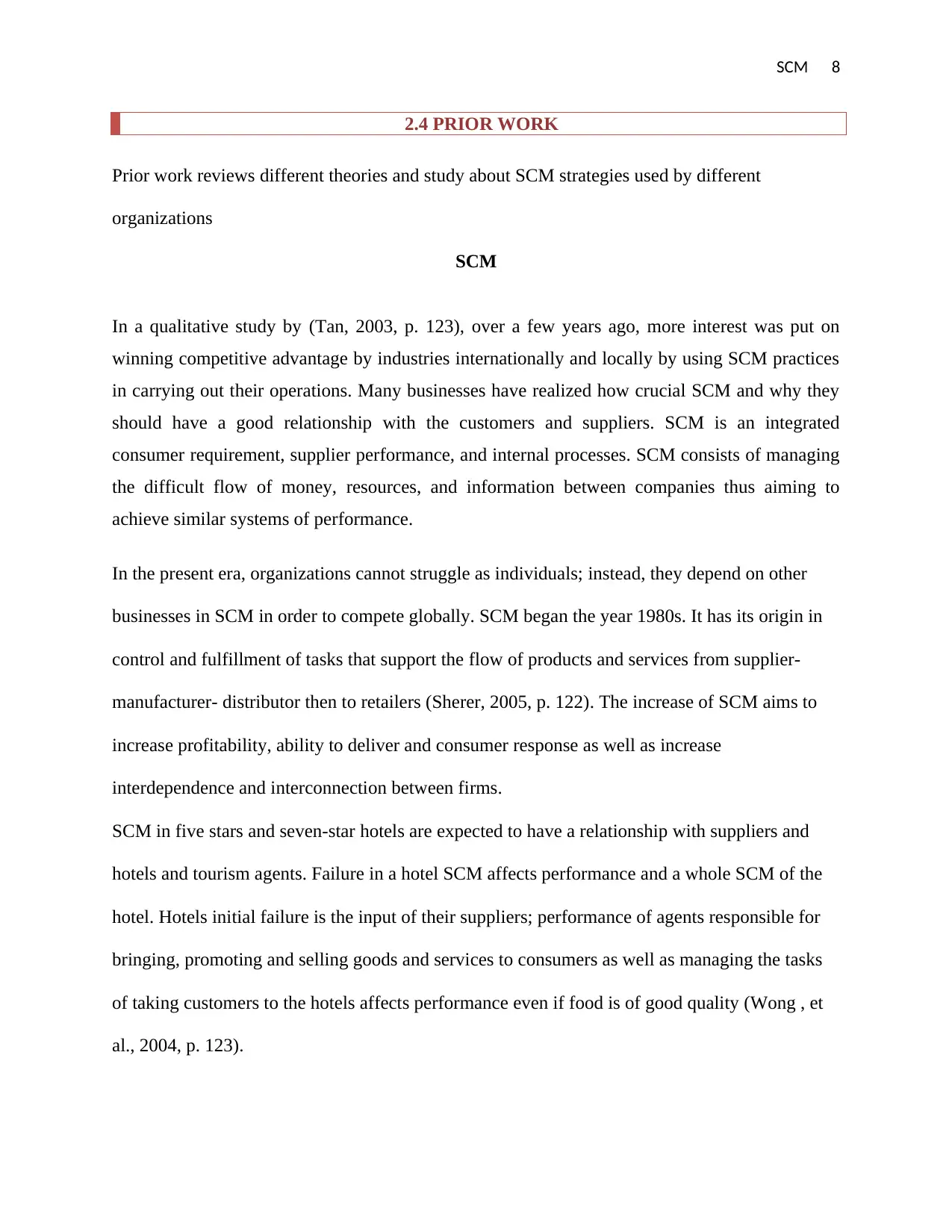
SCM 8
2.4 PRIOR WORK
Prior work reviews different theories and study about SCM strategies used by different
organizations
SCM
In a qualitative study by (Tan, 2003, p. 123), over a few years ago, more interest was put on
winning competitive advantage by industries internationally and locally by using SCM practices
in carrying out their operations. Many businesses have realized how crucial SCM and why they
should have a good relationship with the customers and suppliers. SCM is an integrated
consumer requirement, supplier performance, and internal processes. SCM consists of managing
the difficult flow of money, resources, and information between companies thus aiming to
achieve similar systems of performance.
In the present era, organizations cannot struggle as individuals; instead, they depend on other
businesses in SCM in order to compete globally. SCM began the year 1980s. It has its origin in
control and fulfillment of tasks that support the flow of products and services from supplier-
manufacturer- distributor then to retailers (Sherer, 2005, p. 122). The increase of SCM aims to
increase profitability, ability to deliver and consumer response as well as increase
interdependence and interconnection between firms.
SCM in five stars and seven-star hotels are expected to have a relationship with suppliers and
hotels and tourism agents. Failure in a hotel SCM affects performance and a whole SCM of the
hotel. Hotels initial failure is the input of their suppliers; performance of agents responsible for
bringing, promoting and selling goods and services to consumers as well as managing the tasks
of taking customers to the hotels affects performance even if food is of good quality (Wong , et
al., 2004, p. 123).
2.4 PRIOR WORK
Prior work reviews different theories and study about SCM strategies used by different
organizations
SCM
In a qualitative study by (Tan, 2003, p. 123), over a few years ago, more interest was put on
winning competitive advantage by industries internationally and locally by using SCM practices
in carrying out their operations. Many businesses have realized how crucial SCM and why they
should have a good relationship with the customers and suppliers. SCM is an integrated
consumer requirement, supplier performance, and internal processes. SCM consists of managing
the difficult flow of money, resources, and information between companies thus aiming to
achieve similar systems of performance.
In the present era, organizations cannot struggle as individuals; instead, they depend on other
businesses in SCM in order to compete globally. SCM began the year 1980s. It has its origin in
control and fulfillment of tasks that support the flow of products and services from supplier-
manufacturer- distributor then to retailers (Sherer, 2005, p. 122). The increase of SCM aims to
increase profitability, ability to deliver and consumer response as well as increase
interdependence and interconnection between firms.
SCM in five stars and seven-star hotels are expected to have a relationship with suppliers and
hotels and tourism agents. Failure in a hotel SCM affects performance and a whole SCM of the
hotel. Hotels initial failure is the input of their suppliers; performance of agents responsible for
bringing, promoting and selling goods and services to consumers as well as managing the tasks
of taking customers to the hotels affects performance even if food is of good quality (Wong , et
al., 2004, p. 123).
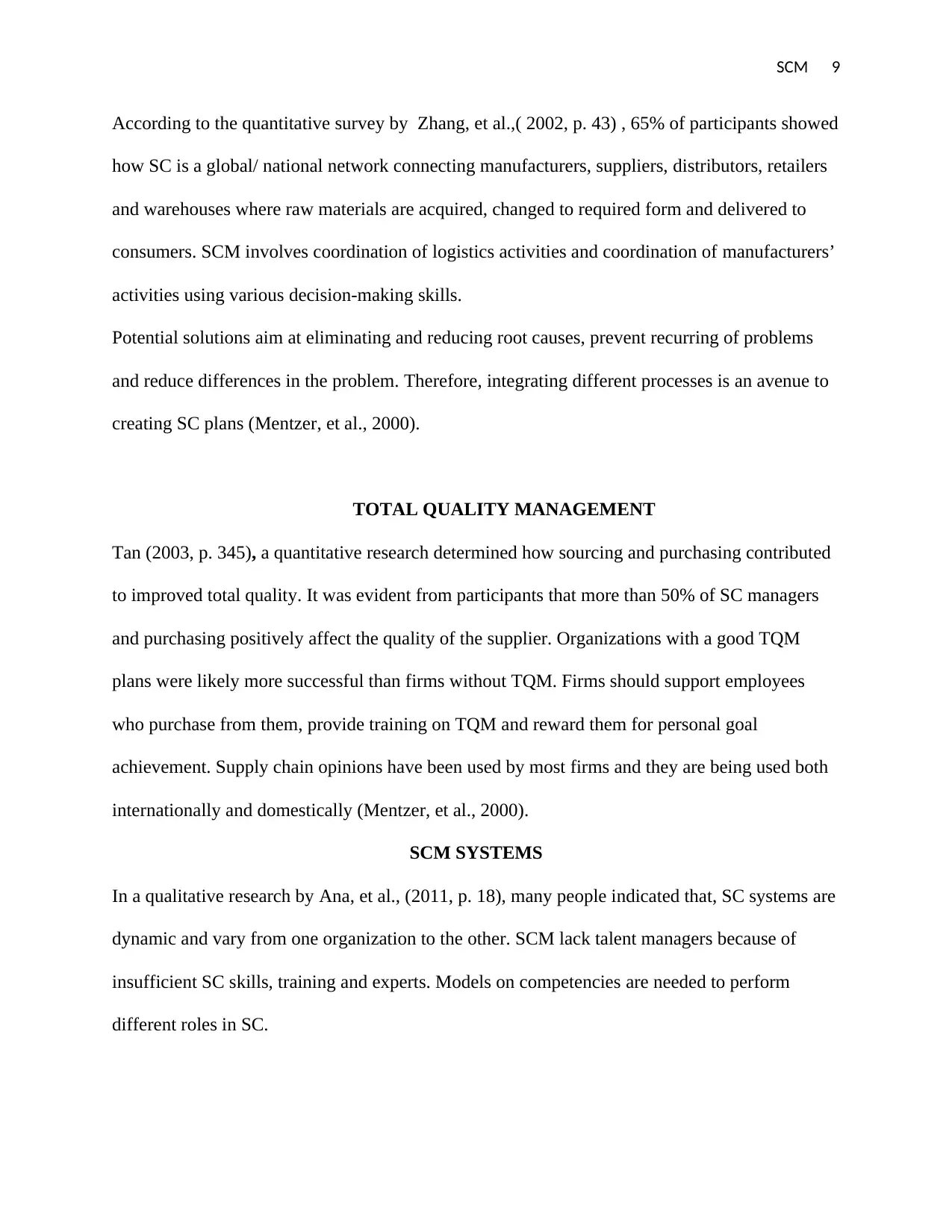
SCM 9
According to the quantitative survey by Zhang, et al.,( 2002, p. 43) , 65% of participants showed
how SC is a global/ national network connecting manufacturers, suppliers, distributors, retailers
and warehouses where raw materials are acquired, changed to required form and delivered to
consumers. SCM involves coordination of logistics activities and coordination of manufacturers’
activities using various decision-making skills.
Potential solutions aim at eliminating and reducing root causes, prevent recurring of problems
and reduce differences in the problem. Therefore, integrating different processes is an avenue to
creating SC plans (Mentzer, et al., 2000).
TOTAL QUALITY MANAGEMENT
Tan (2003, p. 345), a quantitative research determined how sourcing and purchasing contributed
to improved total quality. It was evident from participants that more than 50% of SC managers
and purchasing positively affect the quality of the supplier. Organizations with a good TQM
plans were likely more successful than firms without TQM. Firms should support employees
who purchase from them, provide training on TQM and reward them for personal goal
achievement. Supply chain opinions have been used by most firms and they are being used both
internationally and domestically (Mentzer, et al., 2000).
SCM SYSTEMS
In a qualitative research by Ana, et al., (2011, p. 18), many people indicated that, SC systems are
dynamic and vary from one organization to the other. SCM lack talent managers because of
insufficient SC skills, training and experts. Models on competencies are needed to perform
different roles in SC.
According to the quantitative survey by Zhang, et al.,( 2002, p. 43) , 65% of participants showed
how SC is a global/ national network connecting manufacturers, suppliers, distributors, retailers
and warehouses where raw materials are acquired, changed to required form and delivered to
consumers. SCM involves coordination of logistics activities and coordination of manufacturers’
activities using various decision-making skills.
Potential solutions aim at eliminating and reducing root causes, prevent recurring of problems
and reduce differences in the problem. Therefore, integrating different processes is an avenue to
creating SC plans (Mentzer, et al., 2000).
TOTAL QUALITY MANAGEMENT
Tan (2003, p. 345), a quantitative research determined how sourcing and purchasing contributed
to improved total quality. It was evident from participants that more than 50% of SC managers
and purchasing positively affect the quality of the supplier. Organizations with a good TQM
plans were likely more successful than firms without TQM. Firms should support employees
who purchase from them, provide training on TQM and reward them for personal goal
achievement. Supply chain opinions have been used by most firms and they are being used both
internationally and domestically (Mentzer, et al., 2000).
SCM SYSTEMS
In a qualitative research by Ana, et al., (2011, p. 18), many people indicated that, SC systems are
dynamic and vary from one organization to the other. SCM lack talent managers because of
insufficient SC skills, training and experts. Models on competencies are needed to perform
different roles in SC.
⊘ This is a preview!⊘
Do you want full access?
Subscribe today to unlock all pages.

Trusted by 1+ million students worldwide
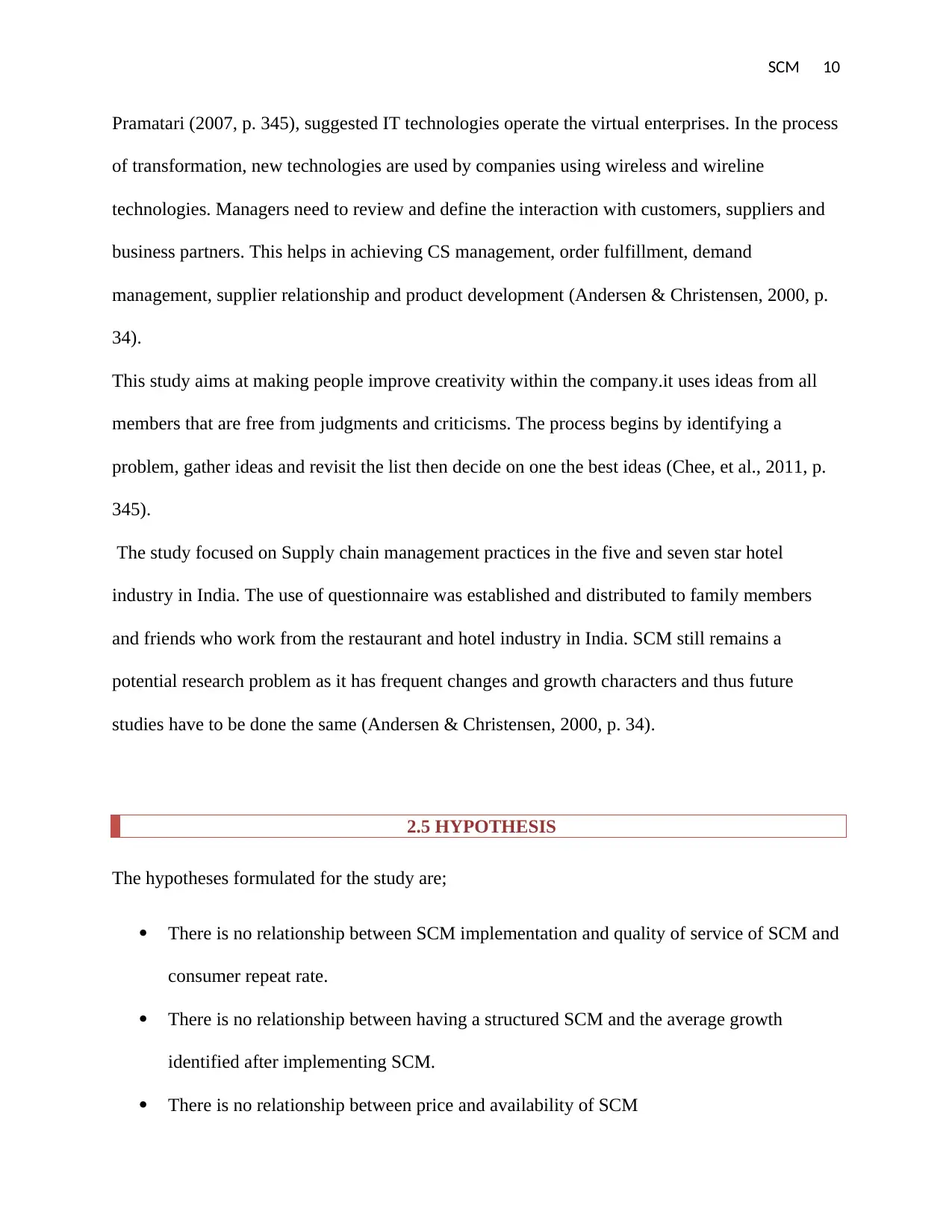
SCM 10
Pramatari (2007, p. 345), suggested IT technologies operate the virtual enterprises. In the process
of transformation, new technologies are used by companies using wireless and wireline
technologies. Managers need to review and define the interaction with customers, suppliers and
business partners. This helps in achieving CS management, order fulfillment, demand
management, supplier relationship and product development (Andersen & Christensen, 2000, p.
34).
This study aims at making people improve creativity within the company.it uses ideas from all
members that are free from judgments and criticisms. The process begins by identifying a
problem, gather ideas and revisit the list then decide on one the best ideas (Chee, et al., 2011, p.
345).
The study focused on Supply chain management practices in the five and seven star hotel
industry in India. The use of questionnaire was established and distributed to family members
and friends who work from the restaurant and hotel industry in India. SCM still remains a
potential research problem as it has frequent changes and growth characters and thus future
studies have to be done the same (Andersen & Christensen, 2000, p. 34).
2.5 HYPOTHESIS
The hypotheses formulated for the study are;
There is no relationship between SCM implementation and quality of service of SCM and
consumer repeat rate.
There is no relationship between having a structured SCM and the average growth
identified after implementing SCM.
There is no relationship between price and availability of SCM
Pramatari (2007, p. 345), suggested IT technologies operate the virtual enterprises. In the process
of transformation, new technologies are used by companies using wireless and wireline
technologies. Managers need to review and define the interaction with customers, suppliers and
business partners. This helps in achieving CS management, order fulfillment, demand
management, supplier relationship and product development (Andersen & Christensen, 2000, p.
34).
This study aims at making people improve creativity within the company.it uses ideas from all
members that are free from judgments and criticisms. The process begins by identifying a
problem, gather ideas and revisit the list then decide on one the best ideas (Chee, et al., 2011, p.
345).
The study focused on Supply chain management practices in the five and seven star hotel
industry in India. The use of questionnaire was established and distributed to family members
and friends who work from the restaurant and hotel industry in India. SCM still remains a
potential research problem as it has frequent changes and growth characters and thus future
studies have to be done the same (Andersen & Christensen, 2000, p. 34).
2.5 HYPOTHESIS
The hypotheses formulated for the study are;
There is no relationship between SCM implementation and quality of service of SCM and
consumer repeat rate.
There is no relationship between having a structured SCM and the average growth
identified after implementing SCM.
There is no relationship between price and availability of SCM
Paraphrase This Document
Need a fresh take? Get an instant paraphrase of this document with our AI Paraphraser
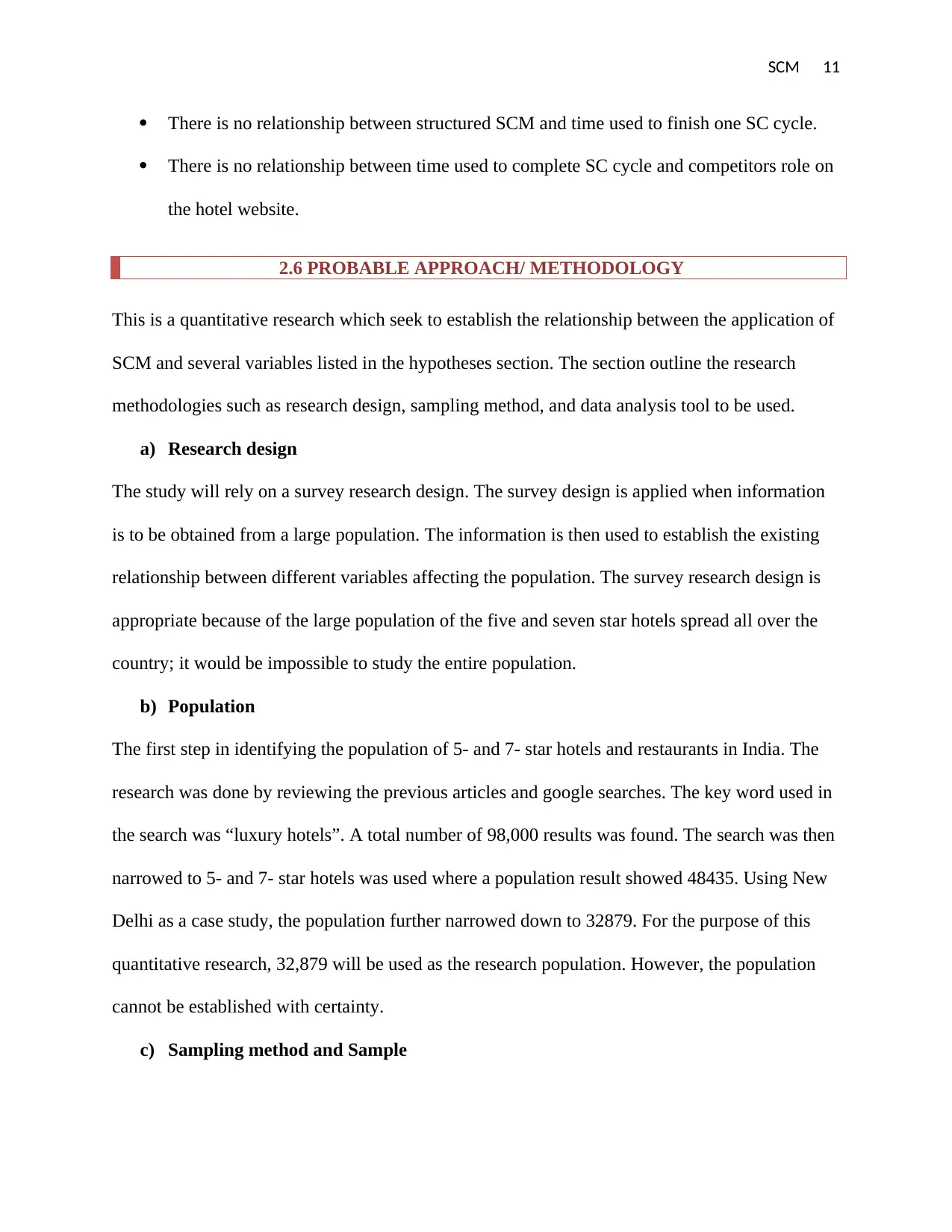
SCM 11
There is no relationship between structured SCM and time used to finish one SC cycle.
There is no relationship between time used to complete SC cycle and competitors role on
the hotel website.
2.6 PROBABLE APPROACH/ METHODOLOGY
This is a quantitative research which seek to establish the relationship between the application of
SCM and several variables listed in the hypotheses section. The section outline the research
methodologies such as research design, sampling method, and data analysis tool to be used.
a) Research design
The study will rely on a survey research design. The survey design is applied when information
is to be obtained from a large population. The information is then used to establish the existing
relationship between different variables affecting the population. The survey research design is
appropriate because of the large population of the five and seven star hotels spread all over the
country; it would be impossible to study the entire population.
b) Population
The first step in identifying the population of 5- and 7- star hotels and restaurants in India. The
research was done by reviewing the previous articles and google searches. The key word used in
the search was “luxury hotels”. A total number of 98,000 results was found. The search was then
narrowed to 5- and 7- star hotels was used where a population result showed 48435. Using New
Delhi as a case study, the population further narrowed down to 32879. For the purpose of this
quantitative research, 32,879 will be used as the research population. However, the population
cannot be established with certainty.
c) Sampling method and Sample
There is no relationship between structured SCM and time used to finish one SC cycle.
There is no relationship between time used to complete SC cycle and competitors role on
the hotel website.
2.6 PROBABLE APPROACH/ METHODOLOGY
This is a quantitative research which seek to establish the relationship between the application of
SCM and several variables listed in the hypotheses section. The section outline the research
methodologies such as research design, sampling method, and data analysis tool to be used.
a) Research design
The study will rely on a survey research design. The survey design is applied when information
is to be obtained from a large population. The information is then used to establish the existing
relationship between different variables affecting the population. The survey research design is
appropriate because of the large population of the five and seven star hotels spread all over the
country; it would be impossible to study the entire population.
b) Population
The first step in identifying the population of 5- and 7- star hotels and restaurants in India. The
research was done by reviewing the previous articles and google searches. The key word used in
the search was “luxury hotels”. A total number of 98,000 results was found. The search was then
narrowed to 5- and 7- star hotels was used where a population result showed 48435. Using New
Delhi as a case study, the population further narrowed down to 32879. For the purpose of this
quantitative research, 32,879 will be used as the research population. However, the population
cannot be established with certainty.
c) Sampling method and Sample
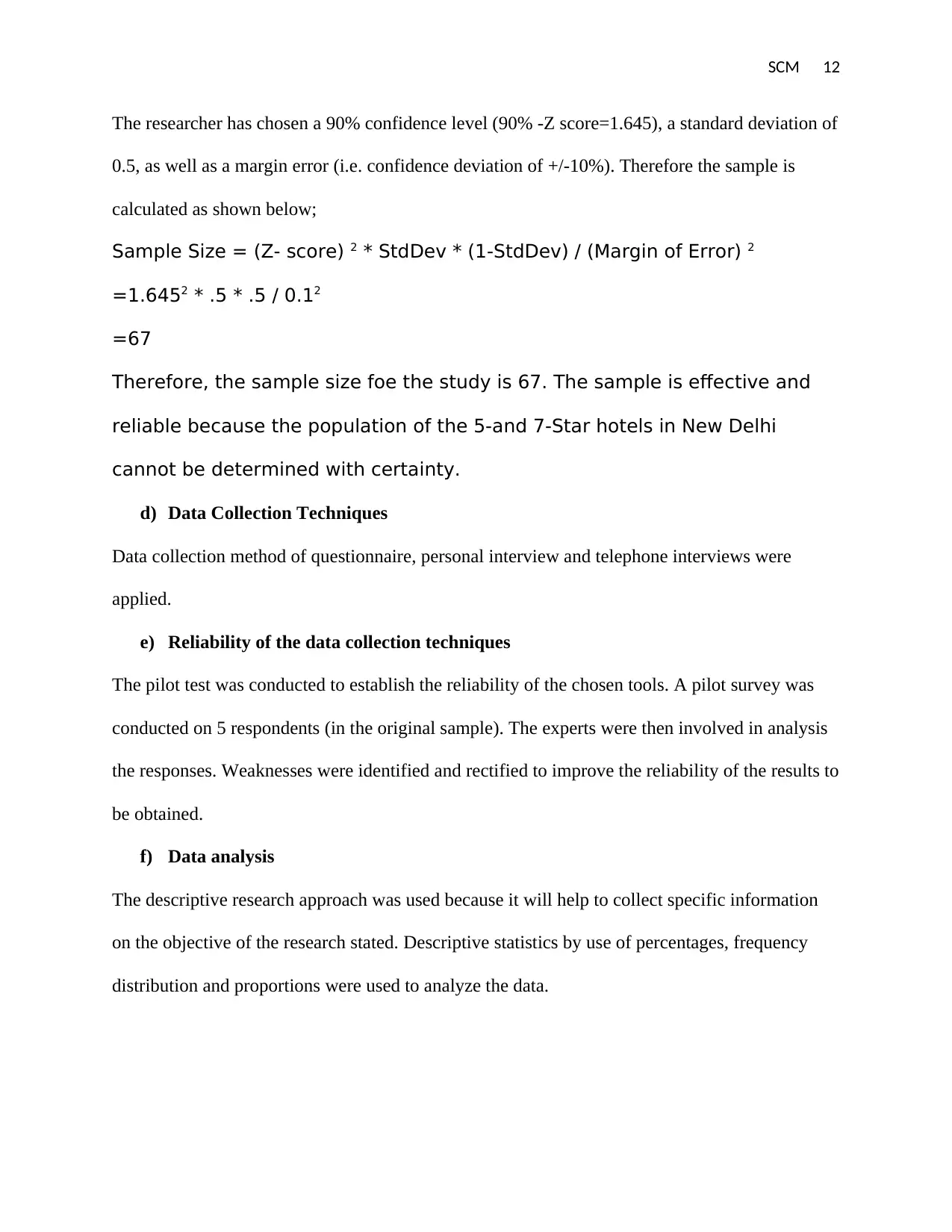
SCM 12
The researcher has chosen a 90% confidence level (90% -Z score=1.645), a standard deviation of
0.5, as well as a margin error (i.e. confidence deviation of +/-10%). Therefore the sample is
calculated as shown below;
Sample Size = (Z- score) 2 * StdDev * (1-StdDev) / (Margin of Error) 2
=1.6452 * .5 * .5 / 0.12
=67
Therefore, the sample size foe the study is 67. The sample is effective and
reliable because the population of the 5-and 7-Star hotels in New Delhi
cannot be determined with certainty.
d) Data Collection Techniques
Data collection method of questionnaire, personal interview and telephone interviews were
applied.
e) Reliability of the data collection techniques
The pilot test was conducted to establish the reliability of the chosen tools. A pilot survey was
conducted on 5 respondents (in the original sample). The experts were then involved in analysis
the responses. Weaknesses were identified and rectified to improve the reliability of the results to
be obtained.
f) Data analysis
The descriptive research approach was used because it will help to collect specific information
on the objective of the research stated. Descriptive statistics by use of percentages, frequency
distribution and proportions were used to analyze the data.
The researcher has chosen a 90% confidence level (90% -Z score=1.645), a standard deviation of
0.5, as well as a margin error (i.e. confidence deviation of +/-10%). Therefore the sample is
calculated as shown below;
Sample Size = (Z- score) 2 * StdDev * (1-StdDev) / (Margin of Error) 2
=1.6452 * .5 * .5 / 0.12
=67
Therefore, the sample size foe the study is 67. The sample is effective and
reliable because the population of the 5-and 7-Star hotels in New Delhi
cannot be determined with certainty.
d) Data Collection Techniques
Data collection method of questionnaire, personal interview and telephone interviews were
applied.
e) Reliability of the data collection techniques
The pilot test was conducted to establish the reliability of the chosen tools. A pilot survey was
conducted on 5 respondents (in the original sample). The experts were then involved in analysis
the responses. Weaknesses were identified and rectified to improve the reliability of the results to
be obtained.
f) Data analysis
The descriptive research approach was used because it will help to collect specific information
on the objective of the research stated. Descriptive statistics by use of percentages, frequency
distribution and proportions were used to analyze the data.
⊘ This is a preview!⊘
Do you want full access?
Subscribe today to unlock all pages.

Trusted by 1+ million students worldwide
1 out of 23
Related Documents
Your All-in-One AI-Powered Toolkit for Academic Success.
+13062052269
info@desklib.com
Available 24*7 on WhatsApp / Email
![[object Object]](/_next/static/media/star-bottom.7253800d.svg)
Unlock your academic potential
Copyright © 2020–2025 A2Z Services. All Rights Reserved. Developed and managed by ZUCOL.





